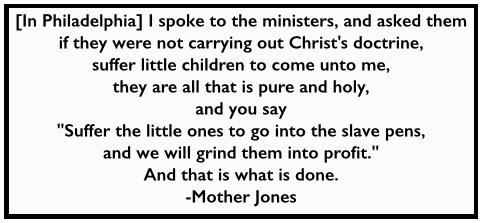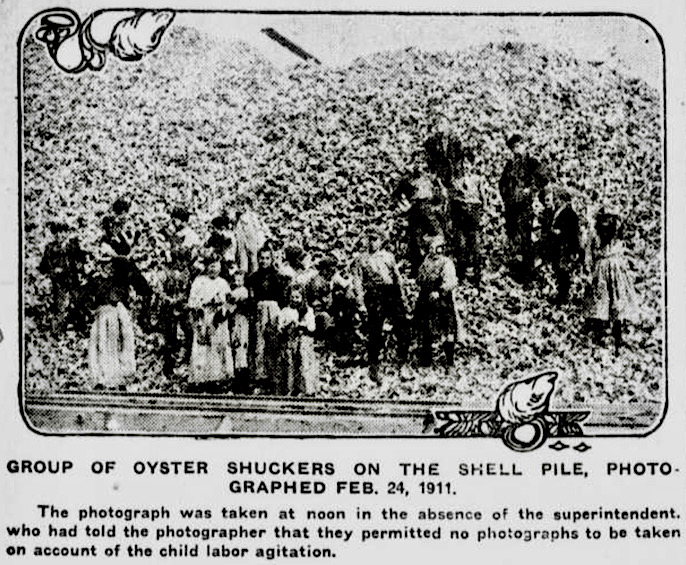 ———————-
———————-
Hellraisers Journal – Tuesday December 19, 1911
Report on Child Labor in Mississippi by E. N. Clopper
-with Photograph of Little Oyster Shuckers by Lewis Hine
From The Hattiesburg News (Mississippi) of December 18, 1911:
CHILD LABOR IN MISSISSIPPI
———————-
By E. N. CLOPPER, Mississippi Valley Secretary
National Child Labor Committee.III.Why Mississippi Should Adopt the Uniform Child Labor Law.
[Part I of II.]
THE investigations covered in article 2 were made before the Mississippi child labor law went into effect. A more recent study of the conditions in April and May, 1911, was made by L. W. Hine, an agent of the national child labor committee. Fortunately, Mr. Hine was able to secure the aid of the camera in communicating his impressions to others. No anonymous or even signed denials can contradict the proof given with photographic fidelity by the camera that the law is being violated.
There has in recent years grown up another child employing industry in Mississippi which in some of its aspects is as bad as the cotton mill. It is the business of shucking and canning oysters and packing shrimps along the gulf coast. These children, in contrast to the children of the cotton mills, who are almost altogether of Mississippi stock, are mostly foreign children imported from Maryland and Delaware, where they are employed in the great truck gardens and berry fields and the vegetable canneries during the summer months, on account of the effective laws of those states, and then are brought to the gulf coast during the shrimp and oyster season. Thus they get no chance at all at an education. Mr. Hine’s report is as follows:
Feb. 24, 1911, I asked the manager of a certain packing house for permission to take some photos, and he said very emphatically that they permitted no one to take photos around the place while workers were there because of the fact they might be used by child labor people. On my own responsibility, then, I visited the plant at 5 a. m., Feb. 25, 1911, before the manager arrived and spent some time there. They all began work that morning at 4 a. m., but it is usually 3 a. m. on busy days. The little ones were there, too, and some babies—one, off in the corner, with a mass of quilts piled over it. From 4 a. m. the entire force worked until 4 p. m., with only enough time snatched from work during the day in which to take a few hurried bites. The breakfast, got in a hurry and in the dark, was not likely very nourishing. Sound asleep on the floor, rolled up against the steam chest, for it was a cold morning, was little Frank, eight years old, a boy who works some. His sister, Mamie, nine years old and an eager, nimble worker, said: “He’s lazy. I used to go to school, but mother won’t let me now because I shuck so fast.” I found considerable complaint about sore fingers caused by handling the shrimps. The fingers of many of the children are actually bleeding before the end of the day. They say it is the acid in the head of the shrimp that causes it. One manager told me that six hours was all that most pickers could stand the work. Then the fingers are so sore they have to stop. Some soak the fingers in an alum solution to harden them. Another drawback to the shrimp packing is the fact that the shrimps have to be kept ice cold all the time to preserve them. It would seem that six hours or less of handling icy shrimps would be bad for the children especially.
The mother of three-year-old Mary said she really does help considerably. So does a five-year-old sister, but they said the youngest was the best worker.

